Top Insecticides for Cabbage Worm Control

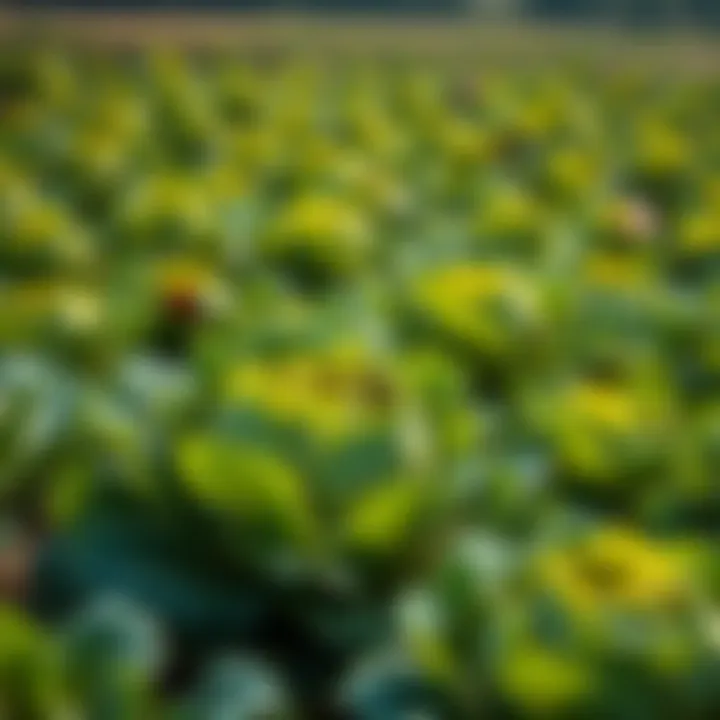
Intro
Cabbage worms are an uninvited nuisance for farmers and gardeners, known for their voracious appetite for cabbage plants. The tiny green devastators emerge from eggs laid by the butterfly's adult stage and can swiftly turn a lush cabbage crop into a lacework of holes. Understanding how to manage these pests effectively is crucial for maintaining healthy crops and ensuring a bountiful harvest. In this piece, we will dive into the world of insecticides tailored for combating cabbage worms, examining both chemical and organic options available.
We’ll also explore application methods, integrating innovative approaches to pest management, and highlight the latest in sustainable farming practices. The goal is to equip agricultural enthusiasts with the insights necessary to tackle cabbage worms effectively, thereby sustaining the environmental balance while enhancing crop productivity.
Key Concepts and Terminology
Definition of Terms
In discussions surrounding pest control, particularly with cabbage worms, it's important to get acquainted with specific terminology:
- Insecticide: A type of pesticide aimed at destroying insects. These can be categorized into chemical and organic.
- Integrated Pest Management (IPM): A sustainable approach that combines multiple strategies for pest control, minimizing reliance on chemical products.
- Larvae: The immature, worm-like stage of insects, in our scenario, referring to cabbage worms.
Overview of Relevant Practices
Understanding the practices to manage cabbage worms can elevate one's pest control strategy:
- Monitoring: Keeping an eye on the cabbage crop allows farmers to identify infestations early.
- Cultural Practices: Rotating crops and managing plant debris can disrupt the life cycle of cabbage worms.
- Chemical Control Methods: Employing targeted insecticides when the infestation reaches economically damaging levels.
- Biological Control: Introducing natural predators or parasites of cabbage worms.
In a nutshell, leveraging the right mix of these practices is key to effective pest management.
Current Trends and Innovations
Latest Research and Developments
Recent advancements in pest control research focus on minimizing the environmental footprint of insecticides while maximizing their effectiveness. Studies reveal that using insecticides derived from natural sources, such as Bacillus thuringiensis, can be a game-changer. This bacterium produces a protein toxic to many insects, including cabbage worms, yet is harmless to humans and beneficial organisms.
Emerging Technologies and Tools
The agricultural industry is seeing the rise of precision agriculture tools, helping to optimize pest management:
- Drones for Monitoring: Farms are adopting drone technology for aerial imagery to pinpoint bug infestations accurately.
- Smart Sprayers: Equipment equipped with sensors that can detect pest levels and spray insecticides only where needed reduces both product usage and environmental damage.
Staying updated with these trends can aid farmers in adopting more effective and eco-friendly methods of pest control.
Practical Applications
Step-by-Step Guides
- Identify the Problem: Regularly inspect your cabbage for signs of cabbage worm damage.
- Choose the Right Insecticide: Research and select between chemical or organic options based on your sustainability goals.
- Application: Follow label instructions meticulously. Generally, applying in the early morning or late afternoon when beneficial insects are less active is advantageous.
- Monitor Post-Application: After treatment, keep an eye on the crop for any signs of residual damage or new infestations.
Troubleshooting Common Issues
Even seasoned farmers may encounter challenges:
- Resistant Populations: If cabbage worms persist, consider rotating insecticides to avoid resistance.
- Non-target Species Impact: Minimize impact on beneficial insects by applying insecticides with targeted action.
- Timing: Incorrect timing of applications can lead to ineffective results. Always monitor the life cycle of the cabbage worm.
"Effective pest management relies not only on the products used but also on the holistic understanding of crop ecology and pest dynamics."
By following these strategies and understanding the dynamics of cabbage worms, agricultural professionals and enthusiasts can significantly enhance their pest control efforts.
For more insights, visit resources like USDA.gov or NC State Extension.
Preamble to Cabbage Worms and Their Impact
The topic of cabbage worms is essential for anyone involved in agriculture, particularly for growers who cultivate cruciferous vegetables such as cabbage, broccoli, and kale. Cabbage worms, scientifically called Pieris rapae, are notorious for causing significant damage to these crops. Understanding their behavior, life cycle, and the potential impact they can have on yields is crucial. This knowledge empowers farmers and enthusiasts to adopt effective control measures, reducing both economic losses and frustration in the field.
Overview of Cabbage Worms
Cabbage worms are the larval form of the cabbage white butterfly. These pests are small, cylindrical, and can vary in color from bright green to a more muted shade, blending seamlessly with the foliage of plants they infest. They are especially fond of feeding on the leaves of cabbage plants, often creating unsightly holes that can mar the aesthetic appeal of the crop and diminish its marketability.
Introducing natural predators and observing for signs of damage, helps keep their population in check. It's important for growers to recognize the distinctive characteristics of cabbage worms so they can take timely action. By understanding these creatures, farmers can fend them off before they become a major invasion.
Life Cycle and Behavior
The life cycle of a cabbage worm is fascinating yet straightforward. It consists of four distinct stages: egg, larva, pupa, and adult. The adult butterflies lay small, white or yellow eggs on the underside of leaves. Within a few days, the eggs hatch into larvae, leading to the notorious cabbage worms.
As these larvae feed voraciously on the foliage, they grow rapidly and can do extensive damage in a short time. After approximately two to three weeks of feasting, they will then pupate, forming a chrysalis that blends with the environment. This process takes around a week or so, which leads to the emergence of new butterflies, ready to lay eggs and start the cycle anew. Understanding their life cycle is vital for implementing effective pest management strategies.
Signs of Infestation
Detecting a cabbage worm problem before it spirals out of control can save crops. Some of the typical signs include:
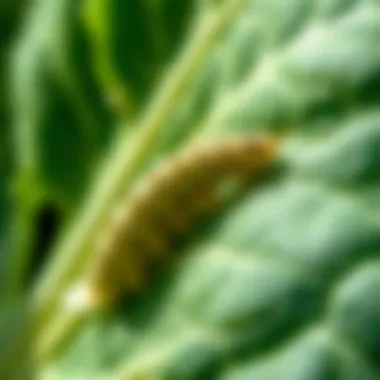
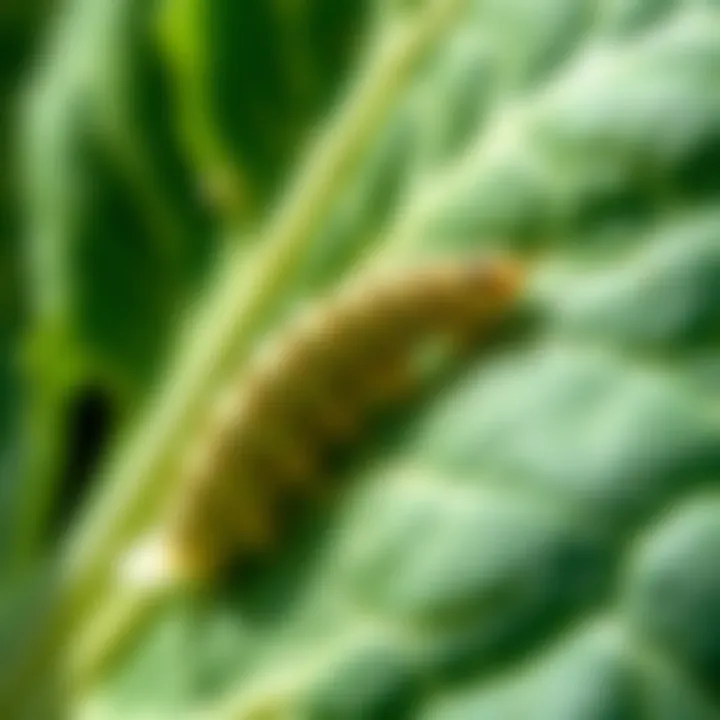
- Visible Damage: Look for holes in the leaves; the size can vary based on the age of the worms.
- Presence of Larvae: Spotting the green caterpillars on the underside of the leaves is a direct indication of infestation.
- Frass: Small pellets of frass (insect waste) might also be observed near affected plants, signaling active feeding.
- Wilting Leaves: In severe cases, plants may begin to wilt or show stunted growth, indicating stress.
Recognizing these signs allows growers to intervene promptly, applying either chemical or organic insecticides as needed. By maintaining vigilance and understanding the biological indicators of cabbage worm presence, farmers can mitigate the risk of crop damage, ensuring healthier plants and better yields.
Understanding Insecticides
In the realm of agriculture, comprehending the various types of insecticides is essential for a successful battle against pests, especially cabbage worms. These products play an integral role in managing pests while ensuring that crop yields remain high and healthy. Understanding insecticides not only helps in selecting the right products but also aids in recognizing how they interact with the environment and the crops themselves.
Every insecticide has a distinct mode of action, which determines how it affects the pests. This can range from disrupting the nervous system of insects to interfering with their ability to feed. Knowing these differences is crucial, as it allows farmers to choose the most effective options while minimizing risks to beneficial organisms and the broader ecosystem.
Definition and Types of Insecticides
At its core, an insecticide is a chemical substance used to control insects. Depending on their formulation, insecticides can be categorized into several types: systemic, which are absorbed by plants and affect insects that feed on them; contact, which kill on touch; and ingestible, which are toxic when consumed. Insect growth regulators also fall under this umbrella as they prevent insects from maturing or reproducing effectively.
Understanding these definitions is fundamental for making informed decisions when tackling pests. It empowers growers to select suitable products tailored for specific situations.
Chemical vs. Organic Insecticides
Choosing between chemical and organic insecticides is a significant consideration in pest management. Each has its advantages and drawbacks, which can influence a farmer's choices based on their goals, practices, and environmental considerations.
Benefits of Chemical Insecticides
Chemical insecticides are known for their rapid action against a wide range of pests, making them a go-to choice for many farmers. One key characteristic is their potency; they often require smaller amounts to achieve significant results. The rapid knockdown effect of such insecticides means that infestations can be controlled quickly, preventing further crop damage and yield loss. However, reliance on chemical insecticides can accumulate environmental concerns over time. This is a balancing act that farmers must navigate, as they weigh efficacy against long-term sustainability.
Pros of Organic Insecticides
Organic insecticides offer a different set of advantages. They tend to be less harmful to non-target organisms, including beneficial insects, birds, and even human health. Moreover, many organic options, like neem oil or insecticidal soap, are derived from natural sources, aligning with the principles of sustainable agriculture. Their slower action may be seen as a drawback, yet this extended effectiveness can be beneficial in reducing pest emergence through long-term strategies. Additionally, utilizing organic insecticides can enhance soil health and promote biodiversity, helping form a more resilient agricultural system.
In summary, understanding insecticides, their definitions, and the comparison between chemical and organic types forms the foundational knowledge necessary for effective pest management strategies. This information not only supports farmers in their immediate goals but also contributes to sustainable practices that protect the environment and ensure the long-term viability of agricultural systems.
"Insecticides are tools; it's how we choose to use them that defines our impact on ecosystems and crop health."
For further exploration on this subject, you may refer to resources such as Wikipedia, Britannica, or local agricultural extension services from *.edu domains.
Chemical Insecticides for Cabbage Worms
Chemical insecticides play a vital role in the management of cabbage worms, offering timely and effective solutions for farmers struggling to keep their crops healthy. The use of these insecticides is particularly important because cabbage worms can devastate crops in a very short period, leading to significant economic losses. Understanding the various types of chemical insecticides available, their mechanisms of action, and the considerations surrounding their use helps farmers make informed decisions that optimize crop yield while minimizing potential drawbacks.
When employing chemical insecticides, it is essential to consider not just their potency against pests but also their impact on the surrounding environment and non-target species. Farmers need to balance efficacy with ecological responsibility. This section explores the various types of chemical insecticides that can effectively address cabbage worm infestations.
Neonicotinoids
Neonicotinoids have emerged as one of the most widely used classes of insecticides for managing pests, including cabbage worms. They work by targeting the nervous system of insects, leading to paralysis and eventual death. One common example is imidacloprid, which has proven effective against various worm species.
- Mechanism of Action: Neonicotinoids bind to nicotinic acetylcholine receptors, resulting in overstimulation of the nervous system. This process is often quick, making them particularly effective in controlling acute infestations.
- Application Considerations: These insecticides can be applied as a soil drench, which allows the plants to absorb the chemical through their roots, providing systemic control. Dialing in the timing of application is critical, as applying them when larvae are actively feeding ensures maximum impact.
However, this class is often scrutinized due to its potential effects on pollinators. Farmers may want to consider floral timing and possibly avoid application during bloom periods to mitigate risks to beneficial insects.
Bacillus thuringiensis (Bt)
Bacillus thuringiensis, often referred to simply as Bt, is a naturally occurring bacterium that has found its niche in organic farming as well as conventional practices. It offers a different mechanism than traditional chemical insecticides.
- Mode of Action: Upon ingestion, Bt produces proteins that are toxic specifically to certain insects, including caterpillars such as cabbage worms. This targeted nature means that beneficial insects are largely unaffected, allowing for a more balanced ecosystem.
- Usage: Application usually involves spraying aqueous formulations onto affected plants. Ideally, farmers should spray Bt in the early morning or late afternoon, when caterpillars are most likely to be feeding.
One advantage of using Bt is that it helps develop a pest management strategy that does not solely rely on synthetic pesticides, thus promoting a more sustainable approach to agriculture. However, resistance can develop if used excessively or improperly, making it vital to rotate with other pest management strategies.
Pyrethroids
Pyrethroids, synthetic versions of pyrethrins found in chrysanthemum flowers, are another important class of chemical insecticides effective against cabbage worms. These act rapidly but have a short residual effect, offering farmers flexibility in their pest management approaches.
- Action Mechanism: These compounds disrupt the normal functioning of the insect nervous system, causing erratic movements and ultimately death. They can be especially effective against the larval stages of cabbage worms.
- Application Techniques: Pyrethroids can be applied through traditional spray methods. They also have a relatively quick knockdown effect, making them applicable for emergencies, although their residual efficacy is limited when exposed to sunlight or rain.
Farmers should be cautious with pyrethroids, as they can also affect other beneficial organisms in the ecosystem. The timing and method of application are crucial to minimize unintended impacts on non-target species.
"Chemical insecticides can be powerful tools in the fight against cabbage worms, especially when used thoughtfully and strategically."
By understanding these chemical insecticides and their specific roles within pest management, farmers can integrate them into a broader pest control plan that ensures the health and sustainability of their cabbage crops.
Organic Insecticides for Cabbage Worms
Organic insecticides are becoming increasingly popular among farmers and gardening enthusiasts who look for methods that stay in harmony with nature. Cabbage worms, notably troublesome pests, can wreak havoc on cabbage crops. Unlike their chemical counterparts, organic insecticides present not only a viable way to manage these pests but also promote sustainable practices. Their use is essential in the dialogue around protecting beneficial insects, soil health, and overall ecosystem balance. Moreover, many modern consumers are leaning toward organic produce, thus adding another layer of incentive for growers to adopt these methods.
Neem Oil
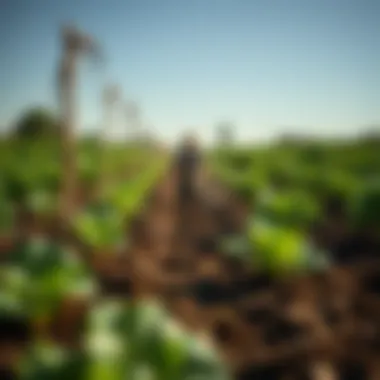

Neem oil is derived from the seeds of the neem tree, Azadirachta indica, and is noted for its ability to deter a range of garden pests. It works wonders against cabbage worms due to its active compound, azadirachtin, which disrupts the insects' hormonal processes. This affects their growth and reproductive capabilities, making it an effective tool in pest management.
Some benefits of neem oil include:
- Natural Affinity: It's safe for non-target species, including pollinators, which means you can use it without worrying too much about collateral damage.
- Dual Action: Not only does it repel pests, but it can also help in preventing fungal infections, which often coincide with infestations.
- User-Friendly: It’s easy to apply, as it can be mixed with water and sprayed directly onto affected plants.
When using neem oil, timing is crucial. Applying it early in the morning or late in the evening prevents direct sunlight from degrading the oil and maximizes its effectiveness. A notable drawback is that it may take time to see results, as it’s more of a preventive measure than an immediate one.
Insecticidal Soap
Insecticidal soap is a rather straightforward and efficient organic pesticide made from natural plant oils and fats. It works by breaking down the protective outer layer of insects, leading to dehydration and ultimately death. This product can be especially effective against cabbage worms if used when infestations are first noticed.
Key characteristics of insecticidal soap include:
- Low Toxicity: Being non-toxic to humans and pets makes it an ideal option for urban growers and home gardeners.
- Quick Action: It acts rapidly; insects can show signs of distress shortly after application.
- Concentration and Mix: Solutions can be easily prepared at home or purchased in ready-to-use bottles. Yet, the concentration must be managed carefully to ensure efficacy without damaging the plants.
It’s wise to apply insecticidal soap during cooler parts of the day. This avoids scorching the plants and works best on soft-bodied insects, like cabbage worms. Repeated applications may be needed for consistent results.
Diatomaceous Earth
Diatomaceous earth (DE) is a unique powder made from fossilized algae, containing silica. Its mode of action against cabbage worms is mechanical rather than chemical. When insects come into contact with the powder, it damages their exoskeleton, leading to dehydration.
The benefits of using diatomaceous earth include:
- Versatility: DE can be used in various settings and against several types of pests, making it a multipurpose gardening tool.
- Chemical-Free: It doesn’t introduce any harmful residues, appealing to those concerned about chemical sensitivities in both crops and consumers.
- Long-Lasting: Once applied, it continues to work as long as it's dry, providing ongoing protection until rain or irrigation washes it away.
However, keep in mind that diatomaceous earth needs to be reapplied after heavy rainfall or watering. Moreover, it should be used in sunny, dry conditions as moisture significantly reduces its effectiveness.
"Organic methods require strategy and patience, but they reward us by fostering healthier ecosystems and producing safe, uncontaminated food."
Incorporating organic insecticides into the routine can create an effective line of defense against cabbage worms and uphold sustainable practices. A holistic approach, combined with keen observation of pest populations and environmental health, can lead to not just better yield but a thriving gardening ecosystem.
Integrated Pest Management Strategies
In the battle against cabbage worms, integrated pest management (IPM) emerges as a strategic approach that combines a variety of methods to achieve effective pest control while ensuring environmental sustainability. This method promotes a balanced ecosystem, aiming to minimize the use of harmful chemicals and reduce the overall pest population through diverse practices. By adopting an integrated strategy, farmers not only protect their crops but also contribute to the health of the surrounding environment.
One of the key benefits of IPM is its holistic nature. Rather than relying solely on chemical insecticides to vanquish pests, IPM incorporates various techniques that work alongside one another. This synergistic approach leads to better pest management, helping to prevent resistant pest populations that can rise when only one control method is employed. Furthermore, it emphasizes continuous monitoring and adapting strategies based on the specific pest dynamics at play.
Cultural Practices
Cultural practices refer to agricultural methods that aim to inherently make the environment less hospitable for pests. For example, rotating crops effectively disrupts the life cycles of cabbage worms. This simple yet powerful technique involves changing the planted crops each season so that pests, which often thrive on specific plants, are deprived of their food sources.
- Field sanitation: Keeping the garden clean by removing debris and old plant material provides fewer hiding places for pests.
- Proper irrigation: Avoiding over-watering can prevent conditions that favor pest development.
- Timing of planting: Planting crops early or late in the season can help avoid peak cabbage worm populations, reducing infestations.
Biological Control Methods
Biological control involves using natural predators or pathogens to manage pest populations. This method not only reduces reliance on chemicals but also fosters a more sustainable pest management system.
A prime example of biological control for cabbage worms is the introduction of beneficial insects such as parasitoid wasps or ladybugs. These insects prey on cabbage worms and their larvae, effectively reducing their numbers without harming the crops.
Additionally, using specific microbes that target these pests can be another avenue. For instance, Bacillus thuringiensis (Bt) is a bacterium that produces a toxin harmful to caterpillars like cabbage worms, but safe for humans and the environment. This method utilizes the natural enemies of the pests at hand.
Planting Resistant Varieties
Another integral strategy within an IPM approach is selecting cabbage varieties that exhibit resistance to cabbage worms. Research has yielded several cabbage types that have genetic traits making them less appealing to these pests or better able to withstand infestations.
Here's how this practice does not only help with pest control but can also enhance overall yield:
- Reduced need for insecticides: By planting resistant varieties, farmers can save on costs associated with purchasing and applying chemical treatments.
- Higher crop resilience: These varieties often exhibit greater growth vigor, which can lead to healthier plants that are more likely to survive pest pressures.
- Sustainability: Practicing resistance planting contributes to a diverse genetic pool, which is critical for cultivating robust agricultural systems.
By implementing these integrated pest management strategies, farmers can tackle cabbage worm issues with a multi-pronged approach that respects both their crops and the environment. This not only enhances agricultural productivity but also aids in the long-term sustainability of farming practices.
Application Techniques for Insecticides
Understanding the right application techniques for insecticides is crucial in the battle against cabbage worms. Applying insecticides effectively not only optimizes their impact but also minimizes potential adverse effects. A well-planned application can substantially reduce worm populations without harming beneficial insects or pollinators. Furthermore, it plays a significant role in maintaining a sustainable approach to agriculture, ensuring crops remain healthy and productive.
Timing of Application
The timing of insecticide application is key for achieving the best results. If you apply insecticides too early, they might break down before the pests arrive. On the other hand, if applied too late, the cabbage worms may already be causing significant damage. Monitoring the life cycle of the cabbage worms can inform when to act. Generally, it’s best to target them during their larval stages when they are actively feeding on the leaves. This way, the insecticides can be most effective in reducing their numbers at a vulnerable juncture.
Methods of Application
Spraying Techniques
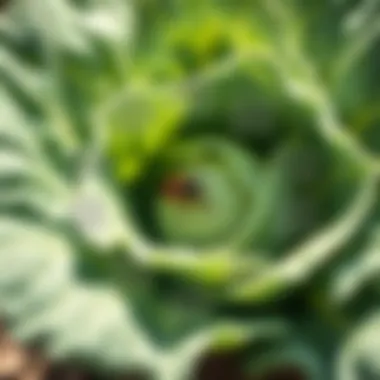

Spraying is a widely used method of applying insecticides due to its direct approach and effectiveness. It allows for uniform coverage of the crop, which is critical, especially when dealing with cabbage worms that tend to hide underneath leaves. One key characteristic of spraying is the ability to penetrate the crop canopy, making sure that all areas are treated. Typically, sprayers can be adjusted to create a fine mist, ensuring that even the smallest nooks get coverage.
This method is popular due to its flexibility—whether using backpack sprayers for smaller gardens or tractor-mounted sprayers for larger fields, it finds its application everywhere. However, spray drift remains a concern. If winds are strong, insecticides can drift away from target plants, impacting non-target areas, including neighboring crops.
A notable advantage of spraying is the speed it offers; it’s generally quick to deploy and can cover expansive areas in less time than some other methods. However, careful consideration for weather conditions—like avoiding rainfall soon after application—is crucial for ensuring the effectiveness of the treatment.
Granular Application
Granular application presents another effective method for delivering insecticides, especially under certain conditions. This method involves using insecticides in a granulated form, which can be spread over the soil or the foliage. One of the appealing traits of granular application is that it can be applied regardless of wind conditions, which makes it a safer option for the environment and nearby ecosystems.
The key benefit of this approach is that it targets the pests more directly. Granular insecticides require moisture to activate their efficacy, which means they can continue to provide action over an extended period after application, especially in conditions with regular rainfall. However, it’s essential to note that this method may not reach pests hiding under leaves as effectively as spraying would.
When choosing between spraying and granular methods, farmers should consider their specific situations. Factors to weigh include the extent of the infestation, weather conditions, and the overall growth stage of the crops. Evaluating the advantages and disadvantages of each method ensures that pest control measures align not just with immediate needs but also with sustainable practices in the long run.
"Proper application techniques are as important as the choice of insecticide itself. Correct timing and method can make or break your pest control efforts."
Thus, properly understanding and analyzing these techniques can significantly influence the success of managing cabbage worms and ensuring a bountiful harvest.
Potential Risks and Considerations
When it comes to managing cabbage worms, the use of insecticides presents noticeable benefits, but it also brings along a host of potential risks and considerations that shouldn't be overlooked. Striking a balance between effectiveness and safety is crucial. Farmers and gardening enthusiasts must grapple with the implications their choices carry not just for their crops, but also for the broader ecosystem and human health. Understanding these risks can lead to more informed decisions in pest control strategies.
Impact on Non-target Species
Introducing insecticides into the environment often has repercussions that stretch beyond the intended targets like cabbage worms. Non-target species, which include beneficial insects like pollinators and natural predatory insects, may be affected by the application of these chemicals.
For instance, when a gardener sprays a potent chemical insecticide, it might eradicate not only the pesky cabbage worms but also ladybugs and lacewings, which help maintain a balanced ecosystem by preying on other pests. This can lead to a cascading effect where beneficial populations dwindle, leaving a vacuum that pests can exploit.
To minimize these impacts, it is essential to:
- Select selective insecticides that specifically target pests without harming beneficial insects.
- Perform applications during times when beneficial insects are less active, such as early mornings or late evenings.
- Implement barrier methods, such as row covers, to protect non-target species while directly targeting the pests.
"Bug bombs might clear pests quick, but collateral damage can bring serious consequences for your garden."
Environmental Concerns
Insecticide use also poses environmental risks that further complicate their utility. Chemicals can journey far beyond their point of application, contaminating soil and water sources. Rainfall and runoff create pathways that can lead to pesticide residue accumulating in local waterways, affecting aquatic life.
Moreover, impacts on soil health can't be ignored. Continuous reliance on chemical solutions may disrupt microbial life in the soil, which is fundamental for nutrient cycling and overall plant health. Healthy soil is crucial for growing robust cabbage crops. The loss of these beneficial microbes can lead to diminished crop yields over time.
To address environmental concerns, consider implementing:
- Integrated Pest Management (IPM), which mixes cultural, mechanical, and biological controls to reduce reliance on chemicals.
- Utilization of biopesticides, which are derived from natural materials and pose less risk to the environment.
- Regular soil health assessments to monitor and mitigate any negative impacts from insecticide application.
Human Health Risks
The risks to human health from insecticides are another critical aspect that requires careful consideration. Often, improper handling or application of insecticides can lead to exposure, resulting in serious health issues. Symptoms of exposure may range from mild irritations to severe illnesses, depending on the chemical's toxicity.
Additionally, there are concerns regarding residues that persist on crops after application. Even though washing fruits and vegetables may reduce some residues, it may not eliminate them entirely. As a precaution, it's advisable to observe preharvest intervals, which suggest how long to wait after applying a pesticide before harvesting crops.
To mitigate human health risks, stakeholders might consider:
- Thorough training on safe handling practices for anyone applying insecticides.
- Adherence to guidelines and regulations as provided by local agricultural extensions or environmental protection agencies (e.g., www.epa.gov).
- Opting for organic insecticides that offer a safer profile for both users and consumers, allowing for peace of mind without sacrificing pest control efficacy.
In summation, while insecticides are vital for managing cabbage worms effectively, awareness of their potential risks is paramount. Recognizing how they affect non-target species, the environment, and human health will foster more targeted, responsible, and sustainable pest management strategies.
Ending and Recommendations
The journey of managing cabbage worms is one that many farmers and gardening enthusiasts encounter. With the right insecticides and strategies, these troublesome pests can be controlled effectively, leading to healthier crops and better yields. This section highlights the key takeaways from the study of insecticides and provides recommendations for future actions.
Summary of Insecticide Options
Insecticides play a critical role in controlling cabbage worms, and choosing the right one can make all the difference. Here's a quick recap of options:
- Neonicotinoids: These systemic insecticides are effective in disrupting the nervous system of cabbage worms and provide long-lasting protection.
- Bacillus thuringiensis (Bt): This biological insecticide is especially favored by organic farmers, as it targets pests without harming beneficial insects.
- Pyrethroids: Known for their fast-acting qualities, these chemicals are derived from chrysanthemum flowers and can effectively eliminate cabbage worms.
- Neem Oil: This organic option not only disrupts hormone systems but also has repellent effects on pests.
- Insecticidal Soap: Targeting soft-bodied insects like cabbage worms, this option is useful for those who prefer a simple yet effective solution.
- Diatomaceous Earth: While more of a physical barrier, it acts by damaging the exoskeletons of insects, thereby reducing their numbers.
Each insecticide type presents its own pros and cons, and selecting one should depend on the specific environment, pest pressure, and desired outcomes.
Best Practices in Pest Management
Effective pest management transcends the mere use of insecticides. Here are some best practices to consider:
- Monitor Pest Populations: Regularly inspect your crops for signs of cabbage worms. Early detection is key to preventing severe damage.
- Implement Integrated Pest Management (IPM): Combine different methods, like crop rotation and biological controls, alongside insecticides for a well-rounded approach.
- Engage in Cultural Practices: Simple actions such as planting at times less favorable to cabbage worm emergence can make a significant difference. This means understanding the life cycle of the pest.
- Adopt Responsible Application: Always follow the instructions on insecticide labels. Overspraying can kill beneficial insects and lead to resistance in pests.
- Educate and Train Staff: Ensure that those involved in crop management are informed about the latest pest control methods and safety practices.
As we move forward, understanding the delicate balance between effective control and environmental stewardship will be vital. Farmers and enthusiasts alike are encouraged to continue learning, experimenting, and sharing insights to improve cabbage worm management strategies.
"The best pesticide is a healthy plant. Stronger plants can withstand pest pressure better than weaker ones."
To discover more effective strategies and resources, consider visiting trusted agricultural sites such as USDA.gov or CDC.gov for the latest guidelines and support.







